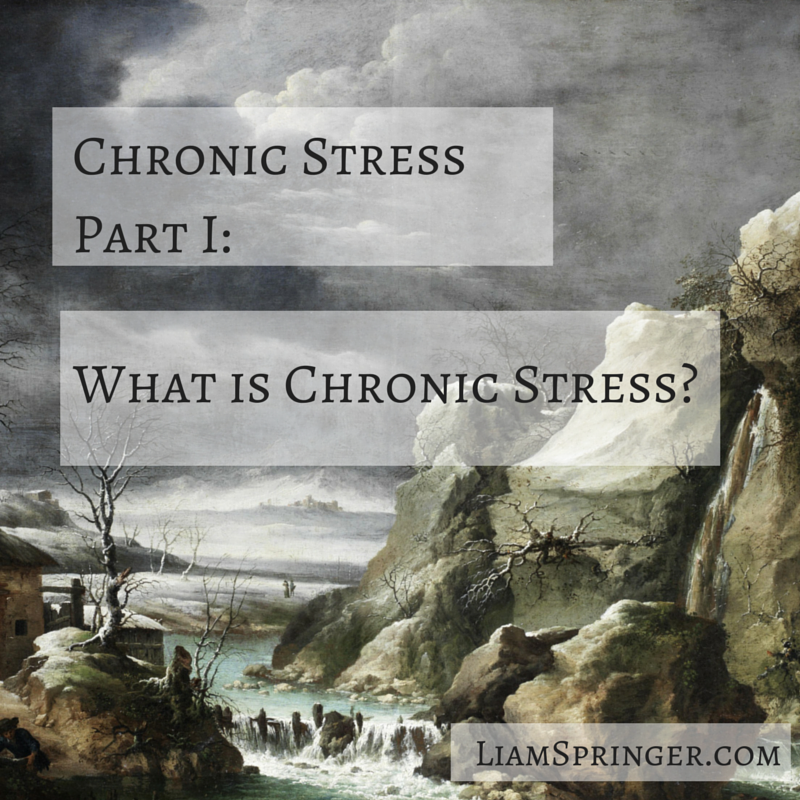
In a previous post, I defined stress and outlined the model for general or acute stress. Now, what is chronic stress?
Chronic stress occurs when the repetitive stress encountered in life does not allow the body the time and energy needed to fully recover. When the intensity, duration, and frequency of the challenges encountered in life results in chronic stress, it will lead to an increasing degeneration of the body’s function.
Some level of demand is perfectly normal and not problematic in itself. The level of challenge presented on our body and our relative ability to meet this challenge determines if and when a challenge will become a stress. If the level of routine challenge is too high, or the ability to meet the challenge is not sufficient, then it is possible the body will fall into a chronically stressed state.
The basic mechanism driving the chronic stress state is the same as the acute stress state. However, the mechanism becomes altered if the body isn’t given time to recover and develop the advanced abilities it needs to deal with the next encounter with a similar challenge. This inability to adapt that leads to chronic stress can result from three basic paths. While the duration of each stress state varies, all paths stem from a lack of sufficient resources needed to meet the demands presented by the challenge.
Basic Paths Leading to Chronic Stress
The first possible reason is that the challenge is so significant that the resulting damage requires an extended period of recovery. In this case the degeneration of the body’s functions will be determined by the intensity of the challenge. Any other challenges encountered while in this compromised state will more significantly impact the body’s function. This includes challenges that would be easily met in other circumstances. Even daily events as basic as digestion and the fasting state during sleep could become stressful after a significant stress.
The second situation which can bring on the chronic stress state is a challenge that is ongoing and keeps the body in a compromised state. In this case the duration is the factor that is the greatest determinant. The length of the stress state will be determined by the length of the challenge. Once again this is likely to increase the stress response to common daily challenges.
The third route that can lead to the chronic stress state is the body’s inability to fully restore itself after the challenge has passed. It is possible that even if the body climbs out of the acute stress state, it still will have have some lingering compromise. If, in this state, the body encounters a similar challenge, it will cause greater damage than in the previous encounter. In this case, the length of the chronic stress will be determined by the frequency of the challenges and the resulting development of degenerated function.
Primary Features of Chronic Stress
The three occurrences above outline the mechanism behind the two primary features of the chronic stress state:
- a constant, ongoing, or routine compromise of function
- frequently being brought into a stress state by challenges that should be easily met
Think of your own experience: a week of high stress at work compounded by a cold makes you less capable to meet the continued stress at work. What may seem like bad luck may in fact be the result of chronic stress.
Chronic stress syndrome will frequently lead to a decline of health; however, the behavior and symptoms can be almost opposite in different individuals. Individuals suffering from chronic stress may have high or low blood pressure, high or low cholesterol, high or low body weight/fat. The consistent feature is an experience of life that is neither easy nor comfortable.
Think of the frail individual who is always cold and prone to illness and infections. They are rather sedentary and need very little to eat, and they have very little reserve for excitement or activity. Any difficulty will completely derail this person’s momentum, and they will withdraw and pray for relief. Missing work and other commitments is routine. Medical specialists often have a host of diagnosis, and a small tote would be necessary to contain all the necessary medications and remedies.
On the other hand, think of someone who is going non-stop: the successful executive who works out at 5 a.m. each morning, doesn’t eat a proper meal until after work, and they don’t sleep more than 6 hours a night. This individual is always eager for action. A cold or infection does not interrupt his activity or exercise, although they frequently have joint aches and repetitive use injuries. They may never miss a day of work, but are constantly irritated to the point that the slightest inconvenience can set them off. They are also not inclined to go to a doctor, but are routinely coming down with one ailment or another. These ailments can range from sinus infections, to ulcers, to hemorrhoids, and they rely heavily on self-prescribed over the counter pharmaceuticals. This person is also under chronic stress, but the perceived productivity of his life is less compromised than that of the frail individual described earlier.
The individual experiencing chronic stress will be perceived by others as “stressed out” whether they are the timid or aggressive type. Often this condition results in the onset of symptomatic syndromes that are frequently misdiagnosed as specific diseases dependent on the organ or system that exhibits the symptoms. The syndromes will vary depending on the environment, personality, physical state, and genetic disposition of the individual involved.
Later, I will outline a few common examples of how the chronic stress state can come about. I will also outline how I believe it can result in the onset of disease.







